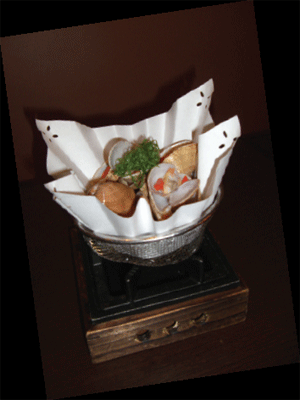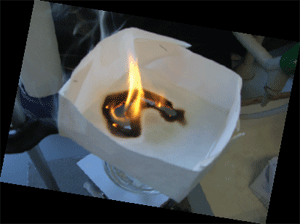Food and Drink
Paper pot fallacy
"It is important to choose the
ingredients carefully. Clams and beef are
more suitable for gentle cooking. If a
strong heat is used, they will become too
tough," the chef said. "A slow and
continuous heat can also enhance the
flavour of the soup."
Lighter ingredients, such as tofu, fish, lean pork and vegetables, are the pick for Japanese paper pots, much different from traditional Chinese hot pots, which usually serve a variety of items including different kinds of meat, seafood and dumpling, in strong-flavoured broth and condiments.
The paper pot cookery, in fact, has
spread its influence on the Chinese menu.
Xiang Tao Japanese Cooking Style on the
Chinese Cuisine, located in Wan Chai, is
one of those local restaurants that serve
Chinese dishes in Japanese paper pots. Its
managing sous chef Tony So Kam-ming
has come up with the dish of braised green
bean leaves with conpoy, or known as
dried scallop, in paper pot.
"Green bean leaves won't be delicious if they are stir-fried for too long," So said.
"Yet, they will taste raw if they are served
too early." The best way to cook green
bean leaves, he said, is to transfer the
vegetables to a paper pot for simmering
under a gentle heat when they are about
70 per cent done.
Besides, desserts are also presented in
paper pots, and Miso Japanese Cuisine is
a pioneer on that in Hong Kong. The local
Japanese restaurant serves, for example,
abekawamochi, a Japanese rice cake, with
black beans and soybean in paper pot.
Jerria Chow Wan-man, assistant marketing manager of Miso, said the dessert was originally planned for winter only as paper pots could warm people up. "But since it is unexpectedly popular, the dish is still kept on the menu," she said.
Despite the popularity of paper pots,
some chemists have doubts about the
safety. "It is dangerous when all the soup
in the paper pot is drunk or evaporated,
as the paper may break and get burnt.
Accidents may occur," said Hui Ka-chung,
a teaching fellow of the chemistry
department at the Chinese University of
Hong Kong.
The high temperature may also lead
to emission of chemicals coated on the
paper. "The amount of impurities in the
paper depends on its production
processes," said Hui, who has conducted
experiments on the paper. "The more
impurities it has, the more harmful
substances will be released upon heating."

Clams in paper pot at Kiya Japanese
Dining Bar.

An experiment shows paper used in paper pots
starts burning when all liquids inside are consumed.